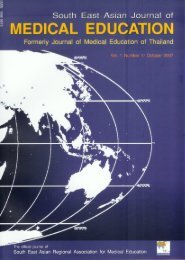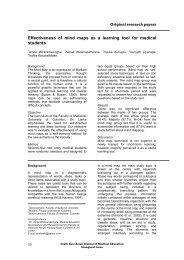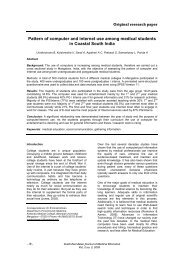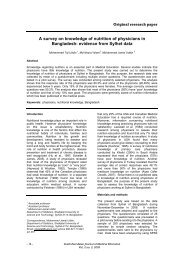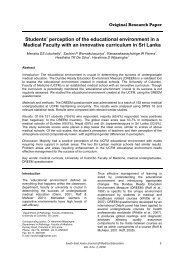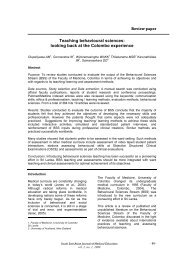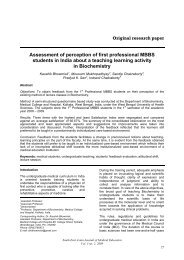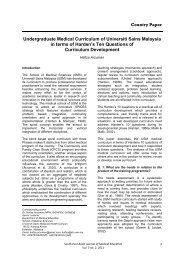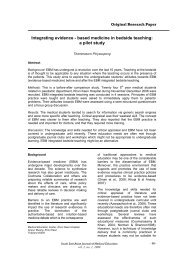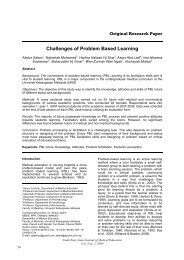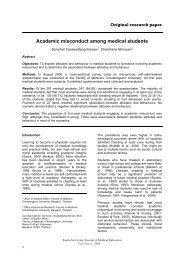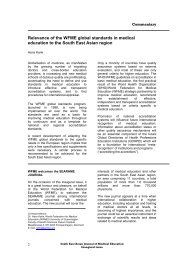Small group facilitation skills in problem-based learning - South East ...
Small group facilitation skills in problem-based learning - South East ...
Small group facilitation skills in problem-based learning - South East ...
Create successful ePaper yourself
Turn your PDF publications into a flip-book with our unique Google optimized e-Paper software.
Lessons for <strong>South</strong> Asia<br />
Workshops to develop <strong>facilitation</strong> <strong>skills</strong> among<br />
<strong>South</strong> Asian medical educators are required.<br />
In <strong>in</strong>stitutions where tra<strong>in</strong><strong>in</strong>g programmes have<br />
been conducted, the sessions were effective <strong>in</strong><br />
improv<strong>in</strong>g <strong>skills</strong> of faculty members and<br />
postgraduates (Baral et al., 2010; Sadaf et al.,<br />
2009; Saeed et al., 2010; Jafri et al., 2007).<br />
Studies to elucidate basel<strong>in</strong>e levels of<br />
<strong>facilitation</strong> <strong>skills</strong> among faculty are also urgently<br />
required. In addition to tra<strong>in</strong><strong>in</strong>g programmes on<br />
PBL and <strong>facilitation</strong>, programmes tailored to<br />
address specific deficiencies noted <strong>in</strong> basel<strong>in</strong>e<br />
studies will also be useful. <strong>Small</strong> <strong>group</strong><br />
learn<strong>in</strong>g us<strong>in</strong>g role plays and other methods<br />
may be ideal to develop such <strong>skills</strong>. Integration<br />
of subjects us<strong>in</strong>g cl<strong>in</strong>ical <strong>problem</strong>s should be<br />
considered. Problem-<strong>based</strong> learn<strong>in</strong>g should<br />
gradually become the more important and the<br />
more widely used method of learn<strong>in</strong>g<br />
compared to didactic lectures.<br />
Encouragement to young medical educators to<br />
become good <strong>problem</strong>-<strong>based</strong> learn<strong>in</strong>g<br />
facilitators should be provided.<br />
References<br />
Azer, S.A. (2005) The qualities of a good teacher:<br />
how can they be acquired and susta<strong>in</strong>ed,<br />
Journal of the Royal Society of Medic<strong>in</strong>e, 98, 2,<br />
pp. 67-69.<br />
Bansal, P. & Supe, A. (2007) Tra<strong>in</strong><strong>in</strong>g of medical<br />
teachers <strong>in</strong> India: need for change, Indian<br />
Journal of Medical Sciences, 61, 8, pp. 478-<br />
484.<br />
Baral, N., Paudel, B.H., Das, BKL, Arval, M.,<br />
Gautam, A. & Lamsal, M. (2010) Prepar<strong>in</strong>g<br />
tutors for <strong>problem</strong>-<strong>based</strong> learn<strong>in</strong>g: An<br />
experience from B. P. Koirala Institute of Health<br />
Sciences, Nepal, Kathmandu University<br />
Medical Journal, 8, pp. 141-145.<br />
Bibace, R., Catl<strong>in</strong>, R.J., Quirk, M.E., Beattie, K.A., &<br />
Slabaugh, R.C. (1981) Teach<strong>in</strong>g styles <strong>in</strong> the<br />
faculty-resident relationship, Journal of Family<br />
Practice, 13, 6, pp. 895-900.<br />
Bligh, J. (2003) The ord<strong>in</strong>ar<strong>in</strong>ess of teach<strong>in</strong>g,<br />
Medical Education, 37, 5, p. 394.<br />
Burdick, W.P., Morahan, P.S. & Norc<strong>in</strong>i, J.J. (2006)<br />
Slow<strong>in</strong>g the bra<strong>in</strong> dra<strong>in</strong>: FAIMER education<br />
programs, Medical Teacher, 28, 7, pp. 631-<br />
634.<br />
Cooke, M., Irby, D.M. & Debas, H.T. (2003) The<br />
UCSF academy of medical education,<br />
Academic Medic<strong>in</strong>e, 78, 7, pp. 666-672.<br />
Crites, G.E., McDonald, S.D. & Markert R.J. (2002)<br />
Teach<strong>in</strong>g EBM <strong>facilitation</strong> us<strong>in</strong>g small <strong>group</strong>s,<br />
Medical Teacher, 24, 4, pp. 442-444.<br />
Dalrymple, K.R., Wuenschell, C., Rosenblum, A.,<br />
Pa<strong>in</strong>e, M., Crowe, D., von Bergmann, H.C.,<br />
Wong, S., Bradford, M.S. & Shuler, C.F. (2007)<br />
PBL core <strong>skills</strong> faculty development workshop<br />
1: An experiential exercise with the PBL<br />
process, Journal of Dental Education, 71, 12,<br />
pp. 249-259.<br />
Das, M., Mpofu, D.J., Hasan, M.Y. & Stewart, T.S.<br />
(2002) Student perceptions of tutor <strong>skills</strong> <strong>in</strong><br />
<strong>problem</strong>-<strong>based</strong> learn<strong>in</strong>g tutorials, Medical<br />
Education, 36, 3, pp. 272-278.<br />
Harden, R.M. & Crosby J. (2000) AMEE Guide no.<br />
20: The good teacher is more than a lecturer –<br />
the twelve roles of the teacher, Medical<br />
Teacher, 22, pp. 334-347.<br />
Hogerzeil, H.V. (ed.) (2001) Teacher’s guide to<br />
good prescrib<strong>in</strong>g, World Health Organization,<br />
Geneva.<br />
Jafri, W., Mumtaz, K., Burdick, W.P., Morahan,<br />
P.S., Freeman, R. & Zehra T. (2007) Improv<strong>in</strong>g<br />
the teach<strong>in</strong>g <strong>skills</strong> of residents as<br />
tutors/facilitators and address<strong>in</strong>g the shortage<br />
of faculty facilitators for PBL modules, BMC<br />
Medical Education, 7, p. 34.<br />
Kim, S., Stevens, N.G. & P<strong>in</strong>sky L. (2003) Cast<strong>in</strong>g<br />
anxiety <strong>in</strong> small <strong>group</strong> <strong>facilitation</strong>: faculty<br />
development via role play, Medical Education,<br />
37, 5, pp. 489.<br />
Leung, K.H., Lue, B.H. & Lee M.B. (2003)<br />
Development of a teach<strong>in</strong>g style <strong>in</strong>ventory for<br />
tutor evaluation <strong>in</strong> <strong>problem</strong>-<strong>based</strong> learn<strong>in</strong>g,<br />
Medical Education, 37, 5, pp. 410-416.<br />
L<strong>in</strong>g, A., Loy, K.J. & Temasek Polytechnic (2007)<br />
Students’ perceptions of good PBL facilitators<br />
[onl<strong>in</strong>e] available at: http://citeseerx.ist.psu.edu<br />
/viewdoc/download%3Fdoi%3D10.1.1.117.272<br />
3% [accessed 8 July 2010].<br />
Norc<strong>in</strong>i, J., Burdick, W. & Morahan P. (2005) The<br />
FAIMER Institute: creat<strong>in</strong>g <strong>in</strong>ternational<br />
networks of medical educators, Medical<br />
Teacher, 27, 3, pp. 214-218.<br />
Pololi, L., Clay, M.C., Lipk<strong>in</strong>, M. Jr., Hewson,<br />
M., Kaplan, C. & Frankel, R.M. (2001)<br />
Reflections on <strong>in</strong>tegrat<strong>in</strong>g theories of adult<br />
education <strong>in</strong>to a medical school faculty<br />
development course, Medical Teacher, 23, 3,<br />
pp. 276-283.<br />
Sadaf, S., Ali, S.K. & Zuberi R.W. (2009) Problem<strong>based</strong><br />
Learn<strong>in</strong>g: Enhanc<strong>in</strong>g Tutors' Facilitation<br />
Skills Us<strong>in</strong>g Structured <strong>Small</strong> Group<br />
Experiential Learn<strong>in</strong>g, Education for Health, 22,<br />
1, p. 96.<br />
<strong>South</strong>‐<strong>East</strong> Asian Journal of Medical Education<br />
Vol. 4 no.2, 2010<br />
21




